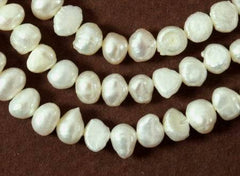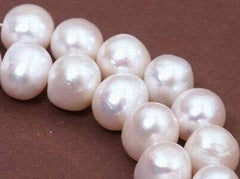24 Unusual Kite Pearls - Beautiful Luster 16mm
Product Code: ga4664
Have a question?
Cultured pearls
Most pearls these days are cultured. These natural freshwater pearls occur in mussels for the same reason saltwater pearls occur in oysters. Foreign material inside a mussel can't be expelled. To reduce irritation, the mollusk coats the intruder with the same secretion it uses for shell-building, nacre. To cultivate a pearl, farmers slit the mussel and insert small pieces of live tissue from another mussel.
Colours
Cultured pearls are now created in all shapes, sizes, and colours: white, silvery-white, pink, red, copper, brown, lavender, purple, green, blue, and yellow. The most desirable are the pastel pinks, roses and lavenders. Natural colour comes from the mussel species and water quality ¨C with pearls taking the colour of the shell in which they form. However, permanent dyes are used today for most saturated colours.
Best pearls
Good pearls have thick overlapping layers of nacre. This can be tested by viewing its lustre. Roll the pearl with a pen in good light - the best pearls will reflect the pen the most. A large pearl is only more valuable if it's the same quality as a smaller one - and the rounder the better. Being an organic gem, grooves, pits, or dents are usual.













 No Internet?
No Internet?




